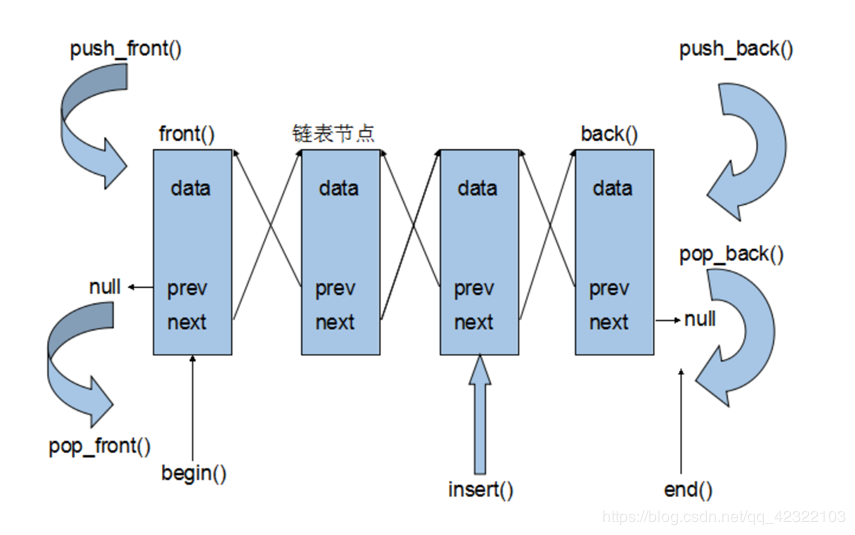list使用详解
List双向链表
再谈链表
List链表的概念再度出现了,作为线性表的一员,C++的STL提供了快速进行构建的方法,为此,在前文的基础上通过STL进行直接使用,这对于程序设计中快速构建原型是相当有必要的,这里的STL链表是单链表的形式。
头文件
头文件:#include<list>
初始化
格式为:explicit list (const allocator_type& alloc = allocator_type());
我们以int类型作为参数为例进行创建,其创建方法与vector无异

list<int> l1; //创建一个空链表
list<int> l2(10); //创建一个链表其有10个空元素
list<int> l3(5,20); //创建一个链表其有5个元素内容为20
list<int> l4(l3.begin(),l3.end()); //创建一个链表其内容为l3的内容
list<int> l5(l4); //创建一个链表其内容为l4的内容
除此之外,还可以直接使用数组来初始化向量:
int n[] = { 1, 2, 3, 4, 5 };
list<int> a(n, n + 5); // 将数组n的前5个元素作为列表a的初值
迭代器
遍历代码举例(其方法和vector版本无异只是更加精简):
list<int> li;
for(list<int>::iterator it=li.begin();it!=li.end();it++){
cout<<*it<<' ';
}
基本操作
3.1 容量函数
- 容器大小:
lst.size(); - 容器最大容量:
lst.max_size(); - 更改容器大小:
lst.resize(); - 容器判空:
lst.empty();
#include <iostream>
#include <list>
using namespace std;
int main(int argc, char* argv[])
{
list<int> lst;
for (int i = 0; i<6; i++)
{
lst.push_back(i);
}
cout << lst.size() << endl; // 输出:6
cout << lst.max_size() << endl; // 输出:357913941
lst.resize(0); // 更改元素大小
cout << lst.size() << endl; // 输出:0
if (lst.empty())
cout << "元素为空" << endl; // 输出:元素为空
return 0;
}
3.2 添加函数
- 头部添加元素:
lst.push_front(const T& x); - 末尾添加元素:
lst.push_back(const T& x); - 任意位置插入一个元素:
lst.insert(iterator it, const T& x); - 任意位置插入 n 个相同元素:
lst.insert(iterator it, int n, const T& x); - 插入另一个向量的 [forst,last] 间的数据:
lst.insert(iterator it, iterator first, iterator last);
#include <iostream>
#include <list>
using namespace std;
int main(int argc, char* argv[])
{
list<int> lst;
// 头部增加元素
lst.push_front(4);
// 末尾添加元素
lst.push_back(5);
// 任意位置插入一个元素
list<int>::iterator it = lst.begin();
lst.insert(it, 2);
// 任意位置插入n个相同元素
lst.insert(lst.begin(), 3, 9);
// 插入另一个向量的[forst,last]间的数据
list<int> lst2(5, 8);
lst.insert(lst.begin(), lst2.begin(), ++lst2.begin());
// 遍历显示
for (it = lst.begin(); it != lst.end(); it++)
cout << *it << " "; // 输出:8 9 9 9 2 4 5
cout << endl;
return 0;
}
li.insert(li.begin(),10); //在链表最前端插入数据10
li.insert(li.begin(),5,20); //在链表最前端插入5个数据内容为20
list<int> k(2,50); //创建一个新的链表k,其拥有2个元素内容均为50
li.insert(li.begin(),li.begin(),li.end()); //在链表v最前端插入链表上K的全部内容
3.3 删除函数
- 头部删除元素:
lst.pop_front(); - 末尾删除元素:
lst.pop_back(); - 任意位置删除一个元素:
lst.erase(iterator it); - 删除 [first,last] 之间的元素:
lst.erase(iterator first, iterator last); - 清空所有元素:
lst.clear();
#include <iostream>
#include <list>
using namespace std;
int main(int argc, char* argv[])
{
list<int> lst;
for (int i = 0; i < 8; i++)
lst.push_back(i);
// 头部删除元素
lst.pop_front();
// 末尾删除元素
lst.pop_back();
// 任意位置删除一个元素
list<int>::iterator it = lst.begin();
lst.erase(it);
// 删除[first,last]之间的元素
lst.erase(lst.begin(), ++lst.begin());
// 遍历显示
for (it = lst.begin(); it != lst.end(); it++)
cout << *it << " "; // 输出:3 4 5 6
cout << endl;
// 清空所有元素
lst.clear();
// 判断list是否为空
if (lst.empty())
cout << "元素为空" << endl; // 输出:元素为空
return 0;
}
li.erase(li.begin()); //删除第一个元素
li.erase(li.begin(),li.begin()+4); //删除前4个元素
3.4 访问函数
- 访问第一个元素:
lst.front(); - 访问最后一个元素:
lst.back();
#include <iostream>
#include <list>
using namespace std;
int main(int argc, char* argv[])
{
list<int> lst;
for (int i = 0; i < 6; i++)
lst.push_back(i);
// 访问第一个元素
cout << lst.front() << endl; // 输出:0
// 访问最后一个元素
cout << lst.back() << endl; // 输出:5
return 0;
}
3.5 其他函数
- 多个元素赋值:
lst.assign(int nSize, const T& x); // 类似于初始化时用数组进行赋值 - 交换两个同类型容器的元素:
swap(list&, list&); 或 lst.swap(list&); - 合并两个列表的元素(默认升序排列):
lst.merge(); - 在任意位置拼接入另一个list:
lst.splice(iterator it, list&); - 删除容器中相邻的重复元素:
lst.unique();
#include <iostream>
#include <list>
using namespace std;
int main(int argc, char* argv[])
{
// 多个元素赋值s
list<int> lst1;
lst1.assign(3, 1);
list<int> lst2;
lst2.assign(3, 2);
// 交换两个容器的元素
// swap(lst1, lst2); // ok
lst1.swap(lst2);
// 遍历显示
cout << "交换后的lst1: ";
list<int>::iterator it;
for (it = lst1.begin(); it!=lst1.end(); it++)
cout << *it << " "; // 输出:2 2 2
cout << endl;
// 遍历显示
cout << "交换后的lst2: ";
for (it = lst2.begin(); it != lst2.end(); it++)
cout << *it << " "; // 输出:1 1 1
cout << endl;
list<int> lst3;
lst3.assign(3, 3);
list<int> lst4;
lst4.assign(3, 4);
// 合并两个列表的元素
lst4.merge(lst3); // 不是简单的拼接,而是会升序排列
cout << "合并后的lst4: ";
for (it = lst4.begin(); it != lst4.end(); it++)
cout << *it << " "; // 输出:3 3 3 4 4 4
cout << endl;
list<int> lst5;
lst5.assign(3, 5);
list<int> lst6;
lst6.assign(3, 6);
// 在lst6的第2个元素处,拼接入lst5
lst6.splice(++lst6.begin(), lst5);
cout << "拼接后的lst6: ";
for (it = lst6.begin(); it != lst6.end(); it++)
cout << *it << " "; // 输出:6 5 5 5 6 6
cout << endl;
// 删除容器中相邻的重复元素
list<int> lst7;
lst7.push_back(1);
lst7.push_back(1);
lst7.push_back(2);
lst7.push_back(2);
lst7.push_back(3);
lst7.push_back(2);
lst7.unique();
cout << "删除容器中相邻的重复元素后的lst7: ";
for (it = lst7.begin(); it != lst7.end(); it++)
cout << *it << " "; // 输出:1 2 3 2
cout << endl;
return 0;
}
排序sort()
#include<iostream>
#include<list>
using namespace std;s
int cmp(const int &a,const int &b){
//简单的自定义降序序列
return a>b;
}
int main(){
list<int> li; //创建一个空链表
for(int i=10;i>=6;i--){
li.push_back(i);
}
li.push_front(3);
li.push_back(20);
list<int> li2(li);
for(list<int>::iterator it=li.begin();it!=li.end();it++){
cout<<*it<<' ';
}
cout<<endl;
//排序前3 10 9 8 7 6 20//
li.sort();
for(list<int>::iterator it=li.begin();it!=li.end();it++){
cout<<*it<<' ';
}
cout<<endl;
//默认排序后 3 6 7 8 9 10 20//
li2.sort(cmp);
for(list<int>::iterator it=li2.begin();it!=li2.end();it++){
cout<<*it<<' ';
}
cout<<endl;
//自定义排序后 20 10 9 8 7 6 3//
return 0;
}
迭代器与算法
1. 迭代器
- 开始迭代器指针:
lst.begin(); - 末尾迭代器指针:
lst.end();// 指向最后一个元素的下一个位置 - 指向常量的开始迭代器指针:
lst.cbegin();// 意思就是不能通过这个指针来修改所指的内容,但还是可以通过其他方式修改的,而且指针也是可以移动的。 - 指向常量的末尾迭代器指针:
lst.cend(); - 反向迭代器指针,指向最后一个元素:
lst.rbegin(); - 反向迭代器指针,指向第一个元素的前一个元素:
lst.rend();
#include <iostream>
#include <list>
using namespace std;
int main(int argc, char* argv[])
{
list<int> lst;
lst.push_back(1);
lst.push_back(2);
lst.push_back(3);
cout << *(lst.begin()) << endl; // 输出:1
cout << *(--lst.end()) << endl; // 输出:3
cout << *(lst.cbegin()) << endl; // 输出:1
cout << *(--lst.cend()) << endl; // 输出:3
cout << *(lst.rbegin()) << endl; // 输出:3
cout << *(--lst.rend()) << endl; // 输出:1
cout << endl;
return 0;
}
2. 算法
- 遍历元素
list<int>::iterator it;
for (it = lst.begin(); it != lst.end(); it++)
cout << *it << endl;
- 元素翻转
#include <algorithm>
reverse(lst.begin(), lst.end());
- 元素排序
#include <algorithm>
sort(lst.begin(), lst.end()); // 采用的是从小到大的排序
// 如果想从大到小排序,可以采用先排序后反转的方式,也可以采用下面方法:
// 自定义从大到小的比较器,用来改变排序方式
bool Comp(const int& a, const int& b)
{
return a > b;
}
sort(lst.begin(), lst.end(), Comp);
总结
可以看到,list 与 vector、deque 的用法基本一致,除了以下几处不同:
- list 为双向迭代器,故不支持
it+=i; - list 不支持下标访问和at方法访问。
因上求缘,果上努力~~~~ 作者:图神经网络,转载请注明原文链接:https://www.cnblogs.com/BlairGrowing/p/13534381.html


